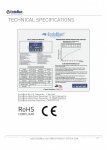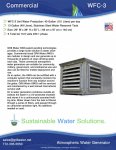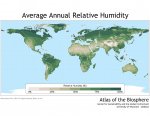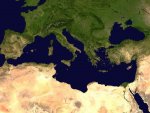Hi
egn, Charlie, dwh,
Many thanks for that quick feedback.
dwh, thanks for the excellent info about
“atmospheric water generators” (
AWG's), machines that condense water from air. I was wondering what those were, as I glanced through the products on the various websites that I listed. They look quite a bit different from Watermakers, which, as you suggest, are really just elaborate filtering or distilling machines.
There's much to be said for
AWG's, because they condense water vapor that would otherwise fall as rain. So water generators in effect collect water that it about as pure as H20 can get in a natural state, just as long as it's not mixed with radioactive fallout……

This may seem a stupid question, but thought I should ask anyway:
Does rainfall still contain some small quantities of impurities that would need to filtered out? Can certain kinds of man-made chemicals go “airborne”, and fall to earth mixed with rain? Or could one reliably expect that an atmospheric water generator would produce pure H2O that needs no further filtration?
If such H20 could still benefit from further filtration, then as
egn suggests, a Katadyn or Seagull filter in the kitchen may prove sufficient.
However, neither of these filters is a water
recycling system, as proposed by
Wayno. And so too, it would seem that an
“atmospheric water generator” cannot function at the same time as a water recycler + filterer, a system that filters water piped in from a lake or stream. Whereas a watermaker like the
Slingshot could do both: it could filter water brought in from outside sources, as well as filter water recycled from the shower and the washing machine.
**************************************
We can break down the problem into three components:
1. Water replenishment
2. Water recycling
3. Water purification
Water replenishment is bringing new water into the system from outside; water recycling is re-using the water that the system already has; and water purification can take place in different locations and to different degrees. For instance, water could be purified one way during the process of replenishment (via a Watermaker, or an atmospheric water generator), and then filtered even further in the kitchen using a Seagull purifier. But used water from a bath, shower, or washing machine might be purified in a slightly different way, than water brought up from a lake, an oasis, or the seaside by a Watermaker.
The problem of having a standard bathtub, then, is primarily a problem of replenishment and/or recycling. If one uses 80 liters a day to take a bath, or the same total amount to take two separate “regular length” showers that use 40 liters each, and if one wants to be able to boondock for 1 month or more, then some kind of replenishment and/or recycling system becomes absolutely essential. Even with a 1000 liter tank like that monster-sized 8x8 UniCat, one would still run out of water after just 12 days, merely to satisfy bathing needs.
Brief Aside:
egn, it's very impressive that you and your wife are now down to
15 l/person/shower. And needless to say, all your earlier suggestions about how a shower column should be configured for maximum efficiency will be taken as "read". For instance, the TerraLiner's shower should have a thermostat with programmable presets for different persons, so that when the water first exits the shower head, it immediately exits at exactly the right temperature. No fiddling necessary with the mixer-tap trying to find the "right" setting, thereby wasting valuable water before getting down to business. So too, no use of an aerated shower-head, but rather, a regular shower head to get an initial "full blast" of water coverage. And so on -- all discussed much earlier in the thread, in post #164 at http://http://www.expeditionportal....pedition-RV-w-Rigid-Torsion-Free-Frame/page17 , and post
#185 at http://www.expeditionportal.com/for...pedition-RV-w-Rigid-Torsion-Free-Frame/page19 .
Now if the TerraLiner were equipped with
only an atmospheric water generator, then one might hope that this could generate at least 100 liters per day, to keep up with all water consumption. But not much more than that. So the EcoloBlue 300 AWG seems like overkill, because it can produce up to 300 liters per day – see
http://store.ecoloblue-world.com/en/48-ecoloblue-300.html and
http://store.ecoloblue-world.com/en/11-industrial-commercial:

And as you stated,
dwh, the EcoloBlue 300 AWG weighs a whopping 380 kg.
The problem seems to be that EcoloBlue's industrial products are all much larger than this, some producing 600, 1,000, 3,000, 5,000 or even 10,000 liters per day – see
http://store.ecoloblue-world.com/en/11-industrial-commercial . At the other end of the spectrum, when one turns instead to EcoloBlue's residential products, these all seem to produce only 8 gallons or 30 liters per day – see
http://store.ecoloblue-world.com/en/6-atmospheric-water-generators ,
http://store.ecoloblue-world.com/en/158-ecoloblue-30me-maximum-efficiency.html ,
http://store.ecoloblue-world.com/en/175-ecoloblue-30-standard-alkaline-appliance.html ,
http://store.ecoloblue-world.com/en/177-ecoloblue-alkaline-30s.html , etc.:
 ​
​
In other words, not nearly enough. And no weights for these units given either. But lots of videos about the EcoloBlue 30 available on the web:
As these videos make clear, there is nothing at all "simple" about these machines, and they too use Reverse Osmosis and UV sterilization, even though they are AWG's, and not Watermakers......
Turning to Oceanbreeze, although it has a webpage and a YouTube channel, further information about its products seems hard to come by – see
http://www.oceanbreezeac.com/water_makers.php and
http://www.youtube.com/user/OceanBreezeAC :
But perhaps Oceanbreeze is merely a distributor for
gr8water products? And in the case of
gr8water, happily enough the range runs from a small unit that produces just 8 gallons or 30 liters per day, to the largest unit that produces 11,356 liters per day – see
http://www.gr8water.net/products/atmospheric-water-generators and
http://www.gr8water.net/products/product-slick-sheets . The two
gr8water units most suited to the TerraLiner are slightly different shapes, but both produce
151 liters per day, which is roughly in the right ball-park:
 ...
... 
Again, for whatever reason, no information given about the weights of these units, just their dimensions.
dwh, might you know how to find out the weights of these AWGs?
But again, these units only produce water; they don't recycle it. Should this matter?
What if the atmospheric water generator breaks down? Taking “normal” showers, washing clothes, cooking meals, and flushing the toilet, will probably consume somewhere between 60 – 100 liters a day. So even with a 600 or 700 liter water tank as per
egn's
Blue Thunder serving as back up, one could remain boondocked at best only another 6 to 10 days.
**************************************
Now perhaps the system gets too complicated if one throws in a relatively small, compact, light-weight Watermaker after all.
egn wrote:
What we are using are the Pentek CBC-10 filters to clean up drinking water and UV desinfection to keep the water pure in a smaller drinking water tank.
Of course, the water shouldn't be really dirty, but any water from a well, clean looking from spring or lake will do. We had never any problems with water the last 8 years. The filter cartridge last for 30.000 - 60.000 l, or 6 - 12 months depending on quality. I exchange the cartridge once a year, it costs about 20 €. In 8 years, which is effectively 1 year full-time use, we have used only about 12.000 l water.
At the moment I don't think that for us a full blown water maker system is really necessary and worth the hassle when traveling. There is a lot of maintenance necessary to keep the system in a pure state.....
But the TerraLiner is being designed with “redundancy” in mind everywhere else. And so a Watermaker serving as backup for the AWG seems like a good idea, too. Furthermore, the Watermaker would be the piece of machinery that recycles waste water from showers and the washing machine, so it seems like a necessary component of a truly complete system. And if/when the AWG eventually breaks down, the Watermaker could serve as backup, pulling in water from a stream, lake, well, or oasis. Also remember: sailboats and power cruisers have been using Watermakers for decades, so I see no reason why one should fear the added “complexity” they introduce into the system. Watermaker technology is not new, various kinds of Watermakers have been preforming well in rugged marine environments for years, and so introducing some kind of Watermaker into the system to handle recycling seems like a rather uncontroversial step.
And if it's ever perfected, the
Slingshot might be the perfect Watermaker for the job....:clapping:
egn: your
Pentek CBC-10 filters could not really act alone as part of a shower-and-washing-machine-water recycling system, could they? Would you be willing to drink the waste-water from showers after it had been passed through
only a
Pentek filter, and nothing else?

What do others think? Would others feel comfortable filling up their freshwater tanks from a stream in Africa or India, purifying their drinking water
only using a Carbon filter such as
egn's
Pentek?
Perhaps I am being a bit paranoid here because of a bout of "Giardia" that I once caught in Nepal -- see
http://en.wikipedia.org/wiki/Giardia . Sure, I had some Metronidazole with me (which Americans commonly call "Flagyl"), and it seemed to go away -- see
http://en.wikipedia.org/wiki/Metronidazole . But then after a few months the diarrhea came back with a vengeance; turns out that the brush with Giardia triggered an autoimmune response that left my upper colon very unhappy for years. After two or three years of chronic diarrhea I was finally diagnosed with Crohn's Disease -- see
http://en.wikipedia.org/wiki/Crohn's_disease . I had only about one meter of fistulas, so I was lucky: they caught it early. But it took two barium enemas and two colonoscopies before they finally succeeded in identifying the problem. The wonderful gastroenterologist who found the Crohn's immediately put me on a ton of Sulfasalazine, and I am now a lucky member of the 10 % of people for whom Crohn's disappears, if caught early enough -- see
http://en.wikipedia.org/wiki/Sulfasalazine . My gastroenterologist did
not have to operate to remove meters of intestine blocked by incurable fistulas.....:Wow1:
...I am no longer symptomatic, I don't have to live with Crohn's for the rest of my life, and so I no longer take the Sulfasalazine.
Now if you know anything about Giardia and Crohn's, or if you've gotten sick from other water-borne disease in the Third world, then you will understand my paranoia here. The story that I recounted was a nightmare that lasted years. Not weeks, not months, but years. I am just lucky that I am German-Canadian who has lived in various countries where health care is free, and I did not have to pay out of pocket for all the tests and procedures.
So to put things bluntly: I personally would never trust
just a carbon filter. Not after what I've been through. No doubt carbon filters have their value, but for me, merely as one step in a multi-stage process that I know will protect me from Giardia, and another relapse of Crohn's.
Remember, India is a country where 72 % of rural people practice "open defecation", and 62 % of all Hindu households, urban or rural, practice open defecation -- see
http://en.wikipedia.org/wiki/Open_defecation ,
http://www.economist.com/news/asia/...es-not-just-building-lavatories-also-changing ,
http://www.economist.com/blogs/graphicdetail/2014/07/daily-chart-13 ,
http://www.bbc.com/news/world-asia-india-27775327 ,
http://www.huffingtonpost.com/2014/05/08/one-billion-open-defecation_n_5289049.html ,
http://www.theguardian.com/global-development/2014/aug/28/toilets-india-health-rural-women-safety ,
http://www.bloomberg.com/apps/news?sid=aErNiP_V4RLc&pid=newsarchive ,
http://www.thehindu.com/opinion/letters/open-defecation/article5474949.ece ,
http://opendefecation.org/news/ , and
http://www.thehindu.com/opinion/lead/the-long-and-short-of-open-defecation/article4505664.ece :
[video=vimeo;97798203]https://vimeo.com/97798203[/video]
...  ....
.... 
Nepal is little different, because 80 % of Nepalis are Hindu -- see
http://en.wikipedia.org/wiki/Religion_in_Nepal . For why religious affiliation should be culturally connected to open defecation, read the articles whose links I just provided. So on my own view, I suffered for years because the cooks on our trek were not sufficiently clean, or they did not boil the cooking and drinking water long enough, or something. All of us on the trek got sick, and we basically got sick via pathogens in effluent that covers the Nepalese and Indian countryside, thanks to open defecation.
**************************************
Also (and this is a really minor point by way of comparison): Could the
Pentek purify sea-water, when the TerrraLiner is parked on a beach beside the ocean?
**************************************
Returning to bathtub design, this discussion of “water replenishment” possibilities as raised by
Wayno has made me wonder all over again what kind of bathtub arrangement might be best. With an AWG and/or a Watermaker constantly replenishing the system, a more regular 80-liter, fill-and-empty bathtub seems possible. If a
gr8water AWG produces 150 liters per day, then water consumption simply won't be a problem. But should one count on the AWG always working?
The
Shachagra solution is inherently conservative and prudential. Even if all water replenishment and water recycling systems fail, with the
Shachagra solution in place, extended boondocking could continue. Via a combination of
dwh “steam showers” + long soaks in the
“Furo” hot-tub, bathing water usage could be kept to 20 liters per day or less. And so the TerraLiner's water tank would go very, very far. There's also something aesthetically pleasing about the idea of soaking in a big 265 liter hot-tub, as opposed to “just” an 80 liter bathtub.
Anyway, just a few more thoughts “on the fly”, so to speak.
Wayno, many thanks for reviving this thread's thinking about the topic of water replenishment and recycling.
Now back to preparing my series of posts advocating the tremendous value of the Chinese Six….

All best wishes,
Biotect

















































